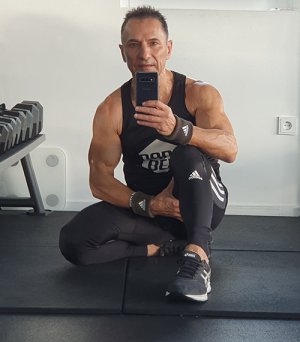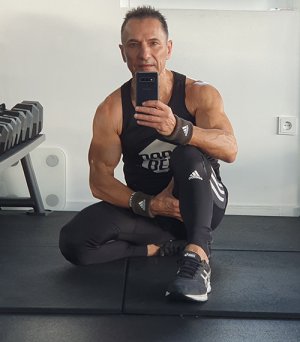@Fremen the moment I started this thread I knew there would be no simple questions to answer.

You're on point in what you asked. The immediate answer to your questions is to say "Yes" to the first (on both counts) and "Yes" to the second. But in order to better understand why the answer is yes and why we have so much difficulty, usually, to optimize training throughout the year if there is no specific goal to drive us.
To answer all this more comprehensively we need to start with your second question, first.
2) If there is no goal to achieve throughout the year, such as important competitions for athletes, does it still make sense to plan an "annual" training?
Everything we do physically has a connected, hidden and absolutely necessary mental component. Bridging the two involves complex neurotransmitter exchange between the brain and the body (which many times involves the gut and our
microbiome). The brain becomes engaged when it is performing a task that arouses it and this arousal, in turn, is reflected in a host of changes in the bloodstream and gut that produce chemicals which make the task we engage in (such as exercise) relevant through a range of signals which lead to physical adaptations in the body (we become stronger, more agile or faster - depending on the specific stimulus we apply tot he body). Boredom is described as a mismatch between an individual’s needed intellectual arousal (which will engage the brain) and the availability of external stimulation without which we are left with, “the aversive experience of wanting, but being unable, to engage in satisfying activity” (the relevant study on this is
here).
When there is no external stimulus that gives a practical achievable target to aim for (such as a competition season for athletes) there is a real danger that we slip into an "always-on" mentality where we do the same things or largely the same things or attend the same routine every day. This, in turn, affects the dopamine response in the brain and dopamine is the central ingredient in the chemical cocktail mix that affects our motivation. How motivated we feel, in turn, affects how the brain perceives our sense of effort and our sense of pain which means that training intensity is affected. That affects the results we achieve and the reward we feel we get, afterwards.
A study on athletes exercising (found
here) showed that those who were bored experienced stronger signals of pain during training than those who were deeply engaged in their training and felt they were working towards a goal. That study's findings have been backed up by a more recent one (found
here) which shows that boredom affects both physical adaptations after training and overall performance during physical exertion.
When even competition athletes can get bored the chances that non-competitive individuals can find themselves 'getting stale' and wanting to take a break are pretty high. Now, let's start to solve this by saying that stopping is not an option. If we exercise regularly we exist in what is called "a trained state" during which the body's dynamic responses adapt for demands that involve the repair of muscle and the building and strengthening of muscle, bone and connective tissue. This is a high-energy demand state which controls how our body uses what we eat and drink and what cycles it prepares for during the day. Stopping training takes it to a "detrained state" where our body's fundamental energy needs undergo a change which also affects its energy apportioning strategy. Muscles become weaker and, at some point, shrink as the body decides to break down excess muscle mass. Bones become weaker and our body's preparatory neurochemical systems that allow us to feel energetic throughout the day, also undergo fundamental changes.
Once the body becomes accustomed to this state it finds it harder to then gear up again making any "stop and start" tactic to fitness harder than it already is. Its cardiovascular and aerobic adaptations are the ones to go first (sometimes even
within two weeks of rest) with muscle mass, body composition and finally, tendon and bone strength following suit, in that order.
So stopping (which may naturally reset our mental excitation levels and help us find our lost motivation) is not a strategy that can work for us. But neither is an "always-on" approach where we need to constantly chase short-term gains of speed, muscle mass and/or strength the answer. As a matter of fact a
2015 study showed that even elite athletes need to ease-off their training in order to maintain their long-term fitness goals.
The answer lies in a mix of three strategies we can adapt to help us be better in what we do.
- Long-term goals - It's important to fully feel (as well as understand) what we are training for. For instance, in my case I had to re-examine why I trained hard when I no longer competed. My current long-term goal lies in a fully-imagined future-me who is strong, healthy and physically autonomous and in control at an age much greater than the one I am currently at. So I workout for that future. Because I understand this is a cumulative-effort approach I see each day as a necessary step to it.
- Short-term aims - Despite our long-term goals it is good to have seasonal aims. For example, during summer when we tend to wear more revealing clothes and be on the beach more a "lean, strong, look" in whatever form works for you, is perfect to help get you through a day's session when you may not feel like it. I tend to use visualizations in my case, when I think of the zombie apocalypse. On days when I really don't feel like training I think that there is no way I will be zombie food. That works for me and gets me through a session at an acceptable level of intensity. I also use summer to do more watersports (upper body work), running outside (aerobic) and hiking (cardiovascular).
- Variety to help us get there - We become bored sometimes because we do the exact same thing, in the exact same way every day and that deadens our mind. Worse than that it fails to prepare us for the effort involved with the net result being that as the time fr the workout approaches we feel an increased sense of resistance building up in us. Mixing thing sup creates spice. If the problem is purely motivational going from a resistance-training regime to an HIIT one, one day, may just rekindle how we feel. Having things we can do on a 'low day' also helps. Again, drawing from my own example, there are days when I'd rather be anywhere than at home, training. On those days I grab my Tablet and Netfix and work on the floor on my flexibility for an hour or hour plus. Whatever I am watching takes the edge off the pain of stretching and spending 90 minutes working on hamstrings, adductors and lower back does me a world of good.
The "annual training" plan then (and we all should be keeping track of what we do and when) is the one that is made up of my long-term goal (always-on), my short-term one (which changes with the seasons) and a variety of exercise routines of mixed intensity that let me take advantage of how I feel for maximum benefits.
All of which now lead us to your first question.

Is there a possible correlation between training and seasons? A sort of natural way to take advantage of the seasons to do an "optimal" workout.
Whether we like it or not we are hardwired to respond to our environment. Sunlight and warmth make us feel good, too much heat or cold make us feel bad. Rain and sleet make us want to hide.
There are four seasons in the year and while some training may be season-agnostic (such as learning to perform specific combat moves) everything else works around the seasonality we experience that links our body's mood (and neurochemical preparation) with the amount of light, heat and/or cold it is exposed to. A study on elite soccer athletes showed that those that ignored seasonality and either trained too much or too little experienced more stress and more injuries as they prepared for their
normal competitive circuit.
Warmer weather places an additional heat load to every form of exercise. But while that excess heat load makes resistance training harder to perform and may result in slower physical strength adaptations as a result, it works the opposite way when it comes to heat efficiency in the body and improved cardiovascular and aerobic fitness. So summer, for example, may be reserved for working on training routines that favor aerobic and cardiovascular fitness and less on strength (in maybe a 60/40 split?). Similarly autumn and winter, depending on where you live, expose us to less sunlight and more cold and resistance training and HIIT may be more beneficial then.
This is always subject to personal experimentation, the ability to understand, truly, what your long-term fitness goals are what your life goals are (and long-tern life and fitness are intimately intertwined) and what you are capable of. I hope all this helped answer what you asked.

 ) so feel free to give me a nudge if you see your question having been missed. I will try to get to each question within 24 hours (coz, dayjob Grrrrrr). Having covered all the necessary rules feel free to open this up by bringing in your questions, thoughts and general queries on how to make training an all-year round thing (which, basically means a lifetime thing).
) so feel free to give me a nudge if you see your question having been missed. I will try to get to each question within 24 hours (coz, dayjob Grrrrrr). Having covered all the necessary rules feel free to open this up by bringing in your questions, thoughts and general queries on how to make training an all-year round thing (which, basically means a lifetime thing).

 from
from
 You're on point in what you asked. The immediate answer to your questions is to say "Yes" to the first (on both counts) and "Yes" to the second. But in order to better understand why the answer is yes and why we have so much difficulty, usually, to optimize training throughout the year if there is no specific goal to drive us.
You're on point in what you asked. The immediate answer to your questions is to say "Yes" to the first (on both counts) and "Yes" to the second. But in order to better understand why the answer is yes and why we have so much difficulty, usually, to optimize training throughout the year if there is no specific goal to drive us. from
from


